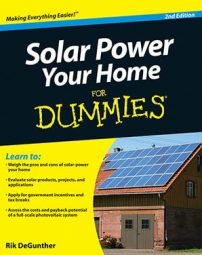To find out how you can green up your lifestyle and reduce your utility bills, you can inspect your house for leaks. After performing this inspection, you can plug up leaks and reduce your energy cost and consumption.
Find leaks
You can save from 5 to 30 percent off your heating and air-conditioning bill simply by plugging up air leaks. To find out if air is entering through an unsealed door, a window, or a vent, you can run a pressure test by sealing your house, turning off heating and cooling sources, extinguishing fireplaces, and turning on exhaust fans.
Go around the house with a bowl of water, dip your hand in, and move your wet hand around windows, electrical outlets, switches, doors, molding interfaces, attic hatches, basement hatches, and so on. You should be able to feel a leak, especially if it's cold outside.
-
Fix door seals: Applying foam weather stripping is easy; it comes in self-stick tapes of various sizes.
-
Window seals: Stationary windows should be well caulked. Get the good stuff, the kind that lasts for 50 years.
-
Heating, ventilation, and air-conditioning: Most ducts send heated or cooled air into the house; one large one is the return. They all need to be tightly sealed. Leaks in the ductwork are worse than air leaks in your house because the ducts are pressurized, which magnifies the amount of air escaping through cracks and openings.
-
Look at faucets, pipes, electrical wiring, and electric outlets from the inside and out: Cracks often form around the junctions where the pipes fit through foundations and siding; fix these with caulk.
-
Check all interfaces between two different building materials: Bricks to foundation; interior corners with molding strips; where siding and foundations meet; roofs to siding; and so on. Plug all holes and voids with caulk.
-
Look for cracks in mortar, foundations, and siding: Seal these with appropriate materials.
-
Check for cracks and voids around exterior doors and windows: These gaps may not result in air leaks inside the house, but check for water leaks to prevent damage that could cost money and turn into air leaks.
-
Check storm windows: The interior window may be well sealed, but the storm window will work better if it's also sealed.
Check insulation
Here are some areas you can focus on:
-
Fix voids around light fixtures by replacing the insulation or filling them with expandable foam insulation.
-
If you have a basement, check to see whether the ceiling is insulated. If not, install insulation.
-
Having the insulation in the attic thickened is easy. You can do this yourself, although make sure that you use a dust mask at all times.
-
Hot water pipes should be well insulated.
Check the details
The following list covers some details that can make a big impact, depending on your home.
-
Increase window insulation: Change to double-paned windows if you can afford it or put up heat-sealing cloth barriers in the summer or storm windows in the winter.
-
Let attics breathe: Attics need to breathe properly. Clean out all vents with one of those extension poles commonly sold for spider webs.
-
Change HVAC filters: You can get really fancy, expensive filters, but it's best to buy a whole box of cheap ones and change them every month or so.
-
Replace or service inefficient HVAC systems: If your HVAC systems are old, they're undoubtedly inefficient. Your best bet is to call an HVAC service company and have someone come out to analyze your equipment.
-
Lower your wattage, and turn off the lights: A 60-watt bulb left on for an hour consumes 0.06 kWh. Ten 60-watt bulbs in recessed lighting in your ceiling turned on for 4 hours consumes 2.4 kWh. At a rate of 15 cents per kWh, this costs 36 cents a day. For a month, the total comes to $10.80, or $130 per year. Fluorescents use much less power to put out the same light intensity. They cost more, but last up to ten times longer.
Analyze your major appliances
To find out how much an appliance costs per month to run, first estimate how much time it's on per day. Then use this formula:
Wattage / 1,000 x (hrs/day) x ($/kWh) x (30 days per month) = total cost per month
A clothes dryer uses 5,570 watts. If you dry clothes for six hours a week, that's 6 hours / 7 days = 0.86 hours per day. Here's what a month's worth of use would cost you:
5,570 / 1,000 x 0.86 x 0.15 x 30 = $21.56 per month
If you put up a clothesline, you save $21.56 per month.

